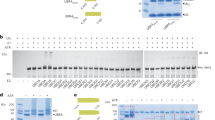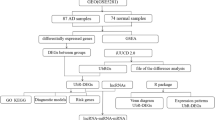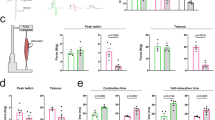Abstract
Episodic ataxias (EAs) are rare neurological channelopathies that are characterized by spells of imbalance and a lack of co-ordination. There are seven clinically recognized EAs and multiple isolated cases. Five disease-causing genes have been identified to date. We describe a novel form of autosomal dominant EA in a large three-generation Irish family. This form of EA presents in early childhood with periods of unsteadiness generalized weakness and slurred speech during an attack, which may be triggered by physical tiredness or stress. Linkage analysis undertaken in 13 related individuals identified a single disease locus (1p36.13-p34.3) with a LOD score of 3.29. Exome sequencing was performed. Following data analysis, which included presence/absence within the linkage peak, two candidate variants were identified. These are located in the HSPG2 and UBR4 genes. UBR4 is an ubiquitin ligase protein that is known to interact with calmodulin, a Ca2+ protein, in the cytoplasm. It also co-localizes with ITPR1 a calcium release channel that is a major determinant of mammal co-ordination. Although UBR4 is not an ion channel gene, the potential for disrupted Ca2+ control within neuronal cells highlights its potential for a role in this form of EA.
Similar content being viewed by others
Log in or create a free account to read this content
Gain free access to this article, as well as selected content from this journal and more on nature.com
or
References
Brandt T, Strupp M : Episodic ataxia type 1 and 2 (familial periodic ataxia/vertigo). Audiol Neurootol 1997; 2: 373–383.
Jen J, Kim GW, Baloh RW : Clinical spectrum of episodic ataxia type 2. Neurology 2004; 62: 17–22.
Escayg A, De Waard M, Lee DD et al: Coding and noncoding variation of the human calcium-channel beta4-subunit gene CACNB4 in patients with idiopathic generalized epilepsy and episodic ataxia. Am J Hum Genet 2000; 66: 1531–1539.
Jen JC, Wan J, Palos TP, Howard BD, Baloh RW : Mutation in the glutamate transporter EAAT1 causes episodic ataxia, hemiplegia, and seizures. Neurology 2005; 65: 529–534.
Gardiner AR, Bhatia KP, Stamelou M et al: PRRT2 gene mutations: from paroxysmal dyskinesia to episodic ataxia and hemiplegic migraine. Neurology 2012; 79: 2115–2121.
Labate A, Tarantino P, Viri M et al: Homozygous c.649dupC mutation in PRRT2 worsens the BFIS/PKD phenotype with mental retardation, episodic ataxia, and absences. Epilepsia 2012; 53: e196–e199.
Stelzl U, Worm U, Lalowski M et al: A human protein-protein interaction network: a resource for annotating the proteome. Cell 2005; 122: 957–968.
Cader MZ, Steckley JL, Dyment DA, McLachlan RS, Ebers GC : A genome-wide screen and linkage mapping for a large pedigree with episodic ataxia. Neurology 2005; 65: 156–158.
Purcell S, Neale B, Todd-Brown K et al: PLINK: a tool set for whole-genome association and population-based linkage analyses. Am J Hum Genet 2007; 81: 559–575.
Abecasis GR, Cherny SS, Cookson WO, Cardon LR : Merlin-rapid analysis of dense genetic maps using sparse gene flow trees. Nat Genet 2002; 30: 97–101.
Li H, Durbin R : Fast and accurate short read alignment with Burrows-Wheeler transform. Bioinformatics 2009; 25: 1754–1760.
McKenna A, Hanna M, Banks E et al: The Genome Analysis Toolkit: a MapReduce framework for analyzing next-generation DNA sequencing data. Genome Res 2010; 20: 1297–1303.
Li H, Handsaker B, Wysoker A et al: The Sequence Alignment/Map format and SAMtools. Bioinformatics 2009; 25: 2078–2079.
Wang K, Li M, Hakonarson H : ANNOVAR: functional annotation of genetic variants from high-throughput sequencing data. Nucleic Acids Res 2010; 38: e164.
Adzhubei IA, Schmidt S, Peshkin L et al: A method and server for predicting damaging missense mutations. Nat Methods 2010; 7: 248–249.
Kumar P, Henikoff S, Ng PC : Predicting the effects of coding non-synonymous variants on protein function using the SIFT algorithm. Nat Protoc 2009; 4: 1073–1081.
Bromberg Y, Rost B : SNAP: predict effect of non-synonymous polymorphisms on function. Nucleic Acids Res 2007; 35: 3823–3835.
Ferrer-Costa C, Gelpi JL, Zamakola L, Parraga I, de la Cruz X, Orozco M : PMUT: a web-based tool for the annotation of pathological mutations on proteins. Bioinformatics 2005; 21: 3176–3178.
Munthe-Fog L, Hummelshoj T, Ma YJ et al: Characterization of a polymorphism in the coding sequence of FCN3 resulting in a Ficolin-3 (Hakata antigen) deficiency state. Mol Immunol 2008; 45: 2660–2666.
Eguchi H, Tsujino A, Kaibara M et al: Acetazolamide acts directly on the human skeletal muscle chloride channel. Muscle Nerve 2006; 34: 292–297.
Gordon N : Episodic ataxia and channelopathies. Brain Dev 1998; 20: 9–13.
Bisdorff AR : Management of vestibular migraine. Ther Adv Neurol Disord 2011; 4: 183–191.
Riss J, Cloyd J, Gates J, Collins S : Benzodiazepines in epilepsy: pharmacology and pharmacokinetics. Acta Neurol Scand 2008; 118: 69–86.
Taft WC, DeLorenzo RJ : Micromolar-affinity benzodiazepine receptors regulate voltage-sensitive calcium channels in nerve terminal preparations. Proc Natl Acad Sci USA 1984; 81: 3118–3122.
Wan J, Mamsa H, Johnston JL et al: Large Genomic Deletions in CACNA1A Cause Episodic Ataxia Type 2. Front Neurol 2011; 2: 51.
Koh SH, Kim HT, Kim SH, Lee GY, Kim J, Kim MH : Spinocerebellar ataxia type 6 and episodic ataxia type 2 in a Korean family. J Korean Med Sci 2001; 16: 809–813.
Nicole S, Davoine CS, Topaloglu H et al: Perlecan, the major proteoglycan of basement membranes, is altered in patients with Schwartz-Jampel syndrome (chondrodystrophic myotonia). Nat Genet 2000; 26: 480–483.
Stum M, Davoine CS, Vicart S et al: Spectrum of HSPG2 (Perlecan) mutations in patients with Schwartz-Jampel syndrome. Hum Mutat 2006; 27: 1082–1091.
Arikawa-Hirasawa E, Wilcox WR, Le AH et al: Dyssegmental dysplasia, Silverman-Handmaker type, is caused by functional null mutations of the perlecan gene. Nat Genet 2001; 27: 431–434.
Kirn-Safran C, Farach-Carson MC, Carson DD : Multifunctionality of extracellular and cell surface heparan sulfate proteoglycans. Cell Mol Life Sci 2009; 66: 3421–3434.
Isom LL, Ragsdale DS, De Jongh KS et al: Structure and function of the beta 2 subunit of brain sodium channels, a transmembrane glycoprotein with a CAM motif. Cell 1995; 83: 433–442.
McCormick KA, Isom LL, Ragsdale D, Smith D, Scheuer T, Catterall WA : Molecular determinants of Na+ channel function in the extracellular domain of the beta1 subunit. J Biol Chem 1998; 273: 3954–3962.
Chen C, Westenbroek RE, Xu X et al: Mice lacking sodium channel beta1 subunits display defects in neuronal excitability, sodium channel expression, and nodal architecture. J Neurosci 2004; 24: 4030–4042.
Liao Y, Anttonen AK, Liukkonen E et al: SCN2A mutation associated with neonatal epilepsy, late-onset episodic ataxia, myoclonus, and pain. Neurology 2010; 75: 1454–1458.
Trudeau MM, Dalton JC, Day JW, Ranum LP, Meisler MH : Heterozygosity for a protein truncation mutation of sodium channel SCN8A in a patient with cerebellar atrophy, ataxia, and mental retardation. J Med Genet 2006; 43: 527–530.
Shim SY, Wang J, Asada N et al: Protein 600 is a microtubule/endoplasmic reticulum-associated protein in CNS neurons. J Neurosci 2008; 28: 3604–3614.
Nakatani Y, Konishi H, Vassilev A et al: p600, a unique protein required for membrane morphogenesis and cell survival. Proc Natl Acad Sci USA 2005; 102: 15093–15098.
DeMaria CD, Soong TW, Alseikhan BA, Alvania RS, Yue DT : Calmodulin bifurcates the local Ca2+ signal that modulates P/Q-type Ca2+ channels. Nature 2001; 411: 484–489.
Liang H, DeMaria CD, Erickson MG, Mori MX, Alseikhan BA, Yue DT : Unified mechanisms of Ca2+ regulation across the Ca2+ channel family. Neuron 2003; 39: 951–960.
Shahidullah M, Santarelli LC, Wen H, Levitan IB : Expression of a calmodulin-binding KCNQ2 potassium channel fragment modulates neuronal M-current and membrane excitability. Proc Natl Acad Sci USA 2005; 102: 16454–16459.
Halling DB, Aracena-Parks P, Hamilton SL : Regulation of voltage-gated Ca2+ channels by calmodulin. Sci STKE 2005; re15.
Lee KY, Kim JS, Kim SH et al: Altered Purkinje cell responses and calmodulin expression in the spontaneously ataxic mouse, Pogo. Eur J Neurosci 2011; 33: 1493–1503.
Bardo S, Cavazzini MG, Emptage N : The role of the endoplasmic reticulum Ca2+ store in the plasticity of central neurons. Trends Pharmacol Sci 2006; 27: 78–84.
Schorge S, van de Leemput J, Singleton A, Houlden H, Hardy J : Human ataxias: a genetic dissection of inositol triphosphate receptor (ITPR1)-dependent signaling. Trends Neurosci 2010; 33: 211–219.
van de Leemput J, Chandran J, Knight MA et al: Deletion at ITPR1 underlies ataxia in mice and spinocerebellar ataxia 15 in humans. PLoS Genet 2007; 3: e108.
Zecevic N, Milosevic A, Ehrlich BE : Calcium signaling molecules in human cerebellum at midgestation and in ataxia. Early Hum Dev 1999; 54: 103–116.
Jiao Y., Yan J, Zhao Y et al: Carbonic anhydrase-related protein VIII deficiency is associated with a distinctive lifelong gait disorder in waddles mice. Genetics 2005; 171: 1239–1246.
Acknowledgements
The authors of this paper would like to thank the family members who participated in the research. We would also like to thank Ataxia Ireland for funding this project. We also thank L Al Gazali for providing additional clinical data related to her patients.
Author information
Authors and Affiliations
Corresponding author
Ethics declarations
Competing interests
The authors declare no conflict of interest.
Additional information
Supplementary Information accompanies this paper on European Journal of Human Genetics website
Supplementary information
Rights and permissions
About this article
Cite this article
Conroy, J., McGettigan, P., Murphy, R. et al. A novel locus for episodic ataxia:UBR4 the likely candidate. Eur J Hum Genet 22, 505–510 (2014). https://doi.org/10.1038/ejhg.2013.173
Received:
Revised:
Accepted:
Published:
Issue date:
DOI: https://doi.org/10.1038/ejhg.2013.173
Keywords
This article is cited by
-
UBE2A and UBE2B are recruited by an atypical E3 ligase module in UBR4
Nature Structural & Molecular Biology (2024)
-
De novo mutations within metabolism networks of amino acid/protein/energy in Chinese autistic children with intellectual disability
Human Genomics (2022)
-
UBR4/POE facilitates secretory trafficking to maintain circadian clock synchrony
Nature Communications (2022)
-
Aberrant UBR4 expressions in Hirschsprung disease patients
BMC Pediatrics (2019)
-
Paroxysmal Movement Disorders: Recent Advances
Current Neurology and Neuroscience Reports (2019)



